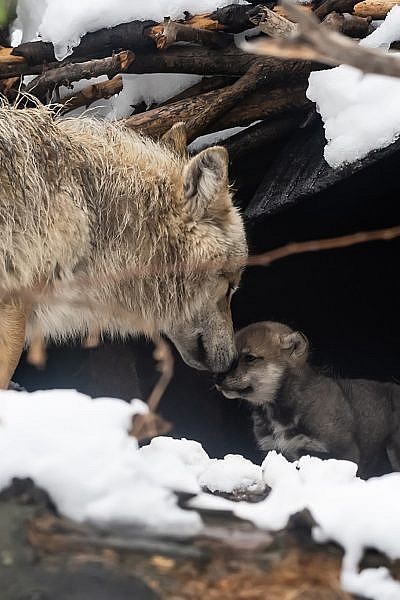Colorado Springs, Colo. – A Mexican wolf pup was born at 5:10 a.m. Friday, April 19, 2019 to second-time parents, Luna and Navarro, to the excitement of Cheyenne Mountain Zoo staff and guests. The pup appears to be strong, and Luna is exhibiting quality maternal instincts.
“It’s very squirmy and snuggly with Luna, and has already grown a lot since it was born on Friday, which is a good sign,” said Dina Bredahl, Rocky Mountain Wild animal manager. “It’s got a really cute full, round belly and dark fur. Mexican wolves grow up to have sandy, gray fur, but their pups are born with dark fur.”
The Rocky Mountain Wild animal care team wasn’t sure how many pups Luna was carrying, and watched for a full 24 hours after the first pup was born before concluding that the pup was a singleton. The newborn pup joins the existing wolf pack consisting of the two parents, Luna and Navarro, and nearly one-year-old sisters Bluestem, Hope and Shadow, and brother Phoenix, who were born May 8 and 9, 2018.
“Wolf packs in the wild will stay together as new litters join the pack, so we don’t see any need to separate the older siblings from this new pup,” said Bredahl. “It’s a win-win for all. The yearlings get to observe Luna with a young pup, which helps them gain experience they can use if they become parents later in life. The single pup benefits because it has a larger pack to learn from and bond with, instead of just its two parents.”
A couple of hours before Luna gave birth early Friday morning, the yearlings were seen on camera in the den nuzzling and cuddling with her.
“It was really cool to see the one-year-olds observing Luna’s behavior, probably noticing something was going on and wondering what was about to happen,” said Bredahl. “Every individual pup makes an impact on the survival of the species, because the Mexican wolf population is so small. Even in human care, we rarely intervene with wolves, so we’re cautiously optimistic that this pup will grow into a healthy adult that can contribute to the long-term survival of Mexican wolves.”
The birth is not only incredibly exciting for the Zoo staff, who have been actively working to successfully breed the species for many years, but it is also highly significant for the future of the species. It is possible that this pup could go on to help repopulate the species in the wild.
For now, Luna is caring for the pup in a cozy underground den within the wolf exhibit. A camera mounted inside the den is connected to a monitor in the guest viewing area, so everyone who visits the Zoo will be able to see live footage of mom and baby at the exhibit.
“From time to time, we see Luna move around outside of the den, carrying the pup with her,” said Bredahl. “We didn’t see that with her litter last year, but that’s probably because this individual pup is so much more ‘portable’ than a full litter. In the wild, mothers will sometimes move their pups from one den to another. Luna has multiple dens in her exhibit, so she’s taking advantage of that and finding the most comfortable spot.”
Cheyenne Mountain Zoo will share photos and video clips of mom and pup, as they become available, on Facebook, Instagram, YouTube and The Waterhole, the Zoo’s monthly e-newsletter.
For many years, the Zoo housed a bachelor pack of wolves, but within the past eight years, the Association of Zoos and Aquariums’ (AZA’s) Species Survival Plan (SSP) has placed various breeding pairs at Cheyenne Mountain Zoo with the hopes of offspring. Until Luna and Navarro, none of the breeding pairs were successful. When they are older, it is possible that Luna’s pups could be released to help provide genetic diversity in the wild.
The birth of this pup is significant because there are currently only 131 Mexican wolves in the wild, and only about 300 in human care. Until the 1900s, the Mexican wolf thrived throughout central Mexico, Arizona, New Mexico and western Texas. But by the 1950s, the species was virtually eradicated, with the last known wild wolf in the U.S. shot in 1970. When the Endangered Species Act went into effect in 1973, it led to the Mexican wolf being declared an endangered subspecies. Their number has since been increasing through captive breeding programs.
The population of Mexican wolves in human care at Association of Zoos and Aquariums (AZA)-accredited zoos is an important part of the plan to repopulate the species in the wild. The Mexican Wolf Recovery Program is run by U.S. Fish & Wildlife Service, with cooperation from the AZA Mexican Wolf Species Survival Plan. Cheyenne Mountain Zoo has been a participant in the program since 1994.
About Cheyenne Mountain Zoo
Cheyenne Mountain Zoological Society was founded in 1926. Today, Cheyenne Mountain Zoo, America’s only mountain zoo, offers comprehensive education programs, exciting conservation efforts and truly fantastic animal experiences. It is Cheyenne Mountain Zoo’s hope that guests fall in love with animals and nature, and take action to protect them. Of the 233 zoos and aquariums accredited by the Association of Zoos and Aquariums (AZA), Cheyenne Mountain Zoo is one of just ten operating without tax support. Cheyenne Mountain Zoo depends on admissions, membership dues, special event attendance and donations for funding.

